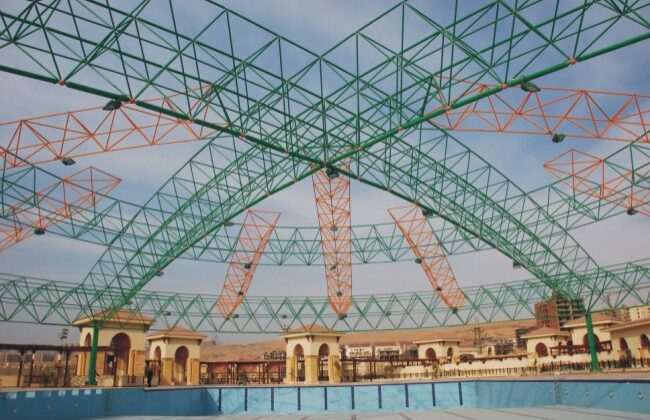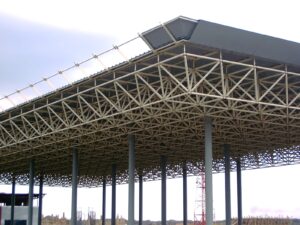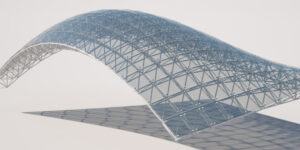Introduction to Space Frame Roofs
Space frame roofs are innovative structural systems that offer unmatched versatility and efficiency for a wide range of architectural applications. Composed of interlocking struts arranged in a geometric pattern, these roofs distribute loads evenly across their framework. Historically, space frames gained prominence in the mid-20th century as a revolutionary approach to creating expansive, unobstructed spaces.
Key Characteristics of Space Frame Roofs
Space frame roofs stand out due to their unique composition and features.
- Structural Composition: Made from a network of rods or tubes, connected at nodes, forming a rigid and stable structure.
- Geometric Configuration: Typically built in triangular, rectangular, or hexagonal grids for optimal load distribution.
- Materials Used: Commonly crafted using steel, aluminium, or composite materials for enhanced durability and lightweight properties.
Types of Space Frame Roof
Space frame roofs can be categorized into three primary types:
- Single-Layer Space Frames: Simple and lightweight, ideal for smaller spans.
- Double-Layer Space Frames: Provide better stability and are suited for medium to large spans.
- Triple-Layer Space Frames: Designed for maximum strength, used in structures with very high loads.
Advantages of Space Frame Roof
The appeal of space frame roofs lies in their numerous benefits:
- Lightweight yet Durable: Despite their lightweight nature, they can bear significant loads.
- Cost-Efficiency: Minimizes material usage, making them an economical choice for large-span structures.
- High Strength-to-Weight Ratio: Ideal for creating expansive, open spaces without heavy supports.
- Aesthetic Appeal: Adds a modern and futuristic look to buildings.
Applications of Space Frame Roof
Space frame roofs find extensive use across various sectors:
- Sports Arenas: Perfect for stadiums and indoor courts.
- Airports: Provide vast, column-free terminal spaces.
- Industrial Buildings: Support heavy machinery with ease.
- Exhibition Halls: Accommodate large crowds and displays.
Technical Aspects of Space Frame Roof Design
Designing a space frame roof involves meticulous technical considerations:
- Load Distribution: Ensures even weight distribution to avoid stress points.
- Joint Design & Node Connections: Precise engineering is required to maintain structural integrity.
- Stress Analysis: Predicts and mitigates potential structural failures.
Popular Materials in Space Frame Roof Construction
Materials used in space frame construction must combine strength and flexibility:
- Steel: Preferred for its robustness and adaptability.
- Aluminium: Lightweight and corrosion-resistant.
- Composites: Increasingly popular for their eco-friendly properties.
Fabrication & Installation Process
Efficient fabrication and installation are crucial for the success of a space frame roof:
- Prefabrication Techniques: Components are manufactured off-site for precision and quality.
- On-Site Assembly: Quick and straightforward assembly reduces construction time.
- Quality Control Measures: Ensures structural soundness and longevity.
Challenges in Space Frame Roof Construction
While advantageous, space frame roof construction is not without challenges:
- Complex Design Requirements: Demands advanced engineering expertise.
- Skilled Labour Dependency: Requires trained professionals for assembly and maintenance.
- Maintenance Considerations: Regular inspections are necessary to prevent long-term issues.
Innovations in Space Frame Roof Technology
Recent advancements have made space frame roofs even more appealing:
- Parametric Design Software: Enables highly customized designs.
- Integration with Solar Panels: Combines aesthetics with energy efficiency.
- Sustainable Material Choices: Reduces environmental impact.
Comparing Space Frame Roof with Other Roofing Systems
Compared to traditional truss or slab systems, space frame roofs provide better flexibility, aesthetic options, and material efficiency.
Aesthetic Potential of Space Frame Roof
Architects can leverage space frame roofs for unique, eye-catching designs that align with both form and function.
Durability & Maintenance of Space Frame Roof
With proper care, space frame roofs offer excellent corrosion resistance and longevity, ensuring decades of reliable service.
Environmental Impact of Space Frame Roof
These structures contribute to sustainability by minimizing material waste and offering energy-efficient design options.
Conclusion
Space frame roofs are a testament to engineering excellence, combining aesthetics, functionality, and cost-effectiveness. As construction technologies evolve, their potential is only set to grow, paving the way for more innovative and sustainable architectural marvels.




